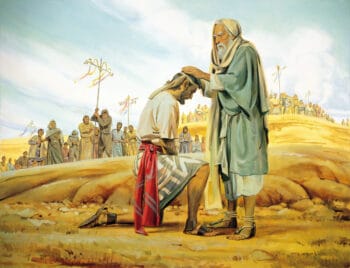
On November 8, 2025, Adventist Today and Spectrum Magazine partnered with Loma Linda University Church to host a discussion on the banned book “Reclaiming the Prophet”. The event featured a distinguished lineup of panelists—all contributors to the book: Terrie Dopp Aamodt, Niels-Erik Andreasen, Jonathan Butler, Lawrence T. Geraty, Ronald D. Graybill, and Gilbert M. Valentine. […] Source: https://atoday.org/adventinnovate-reclaiming-the-prophet-special-event/
 LESSONS OF FAITH FROM JOSHUA
LESSONS OF FAITH FROM JOSHUA Lesson 10 : The True Joshua
Lesson 10 : The True Joshua 10.3 Joshua, the Type
10.3 Joshua, the Type  Moses, Joshua – and the True Redeemer: Christ as the Fulfillment of God’s Plan
Moses, Joshua – and the True Redeemer: Christ as the Fulfillment of God’s Plan Introduction
Introduction BIBLE STUDY
BIBLE STUDY Parallels between Moses and Joshua – Typology in the Bible
Parallels between Moses and Joshua – Typology in the Bible Answers to the Questions
Answers to the Questions Question 1: What significance do the many parallels between the lives of Moses and Joshua have in light of biblical typology? (See Exodus 3:1–2; Joshua 1:1–3; Numbers 13:1–2; Joshua 2:1; Exodus 3:5; Joshua 5:15.)
Question 1: What significance do the many parallels between the lives of Moses and Joshua have in light of biblical typology? (See Exodus 3:1–2; Joshua 1:1–3; Numbers 13:1–2; Joshua 2:1; Exodus 3:5; Joshua 5:15.) Life Application
Life Application Conclusion
Conclusion Thought of the Day
Thought of the Day Illustration
Illustration Epilogue
Epilogue 2 December 2025
2 December 2025 Daniel – Strong in Faith. Faithful in the Fire
Daniel – Strong in Faith. Faithful in the Fire 3. Steadfast in the Small Things – Faithfulness Begins in Everyday Life
3. Steadfast in the Small Things – Faithfulness Begins in Everyday Life Daily Verse
Daily Verse Introduction: The small things say everything
Introduction: The small things say everything Devotion: How faithfulness grows in the hidden
Devotion: How faithfulness grows in the hidden What does this mean for us?
What does this mean for us? What we can learn from Daniel
What we can learn from Daniel Practical steps for today
Practical steps for today Questions for reflection
Questions for reflection Prayer
Prayer Key thought of the day
Key thought of the day ────────────────
────────────────
 (
(